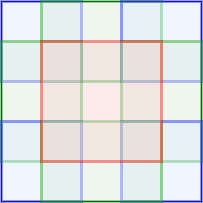Hi,
I am trying to understand how Adaptive Average Pooling 2D works but I could not find a detailed explanation on google.
I did a small test on a 5x5 tensor.
import torch
import torch.nn.functional as F
x = torch.rand(1, 1, 5, 5)
# x: tensor([[[[0.7984, 0.6614, 0.4994, 0.9424, 0.8370],
# [0.9245, 0.0681, 0.8324, 0.9549, 0.8145],
# [0.6221, 0.1108, 0.5670, 0.2415, 0.4548],
# [0.1318, 0.3454, 0.5996, 0.4357, 0.1078],
# [0.3747, 0.5511, 0.5398, 0.2429, 0.6817]]]])
ret = F.adaptive_avg_pool2d(x, (3, 3))
# ret: tensor([[[[0.6131, 0.6598, 0.8872],
# [0.3671, 0.4617, 0.5015],
# [0.3507, 0.4524, 0.3670]]]])
It seems the average is computed in the cells as follows

I search the source code of PyTorch and it leads me to SpatialAdaptiveAveragePooling.c and its cuda counterpart. There are two ways to do the partition, defined as
#define START_IND(a,b,c) (int)floor((float)(a * c) / b)
#define END_IND(a,b,c) (int)ceil((float)((a + 1) * c) / b)
// #define START_IND(a,b,c) a * c / b
// #define END_IND(a,b,c) (a + 1) * c / b + ((a + 1) * c % b > 0)?1:0
int istartH = START_IND(oh, osizeH, isizeH);
int iendH = END_IND(oh, osizeH, isizeH);
int kH = iendH - istartH;
In my example, the height and width are same so we only consider height. We have the followings:
oh 0 1 2
istartH 0 1 3
iendH 1 3 5
kH 1 2 2
But it seems the actual result computes these statistic following the definition in the comment.
// #define START_IND(a,b,c) a * c / b
// #define END_IND(a,b,c) (a + 1) * c / b + ((a + 1) * c % b > 0)?1:0
oh 0 1 2
istartH 0 1 3
iendH 2 4 5
kH 2 3 2
Is there something in the source I missed?
Many thanks!